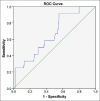Incidence and quantification of corneal haze by Pentacam Scheimpflug densitometry following photorefractive keratectomy for myopia in virgin and post corneal transplant eyes with dark irides
- PMID: 33542980
- PMCID: PMC7849850
- DOI: 10.4103/1319-4534.301295
Incidence and quantification of corneal haze by Pentacam Scheimpflug densitometry following photorefractive keratectomy for myopia in virgin and post corneal transplant eyes with dark irides
Abstract
Purpose: To assess the incidence and quantification of corneal haze after myopic photorefractive keratectomy in virgin and post corneal transplant eyes with dark irides.
Methods: In this retrospective study at the tertiary eye hospital, the corneal haze was evaluated by slit-lamp and quantified by Pentacam Scheimpflug densitometry after myopic photorefractive keratectomy with mitomycin C in virgin eyes (group I) and post corneal transplant eyes (group II) with dark irides over 12 months.
Results: Group I compromised 126eyes from 77patients (35males and 42females) aged 31.31 years (24.11-36.18 years), and group II compromised 44eyes from 33patients (18males and 15females) aged of 32.25 years (26.15-36.66 years). The incidence of corneal haze was 9.5% (95%CI: 5.0%-16%) and 6.8% (95%CI: 1.4-18.7%) in group I and II respectively (P = 0.587). The corneal densitometry was 22.69 ± 8.28GSU preoperatively and 17.98 ± 3.13GSU at 12 months postoperatively (P = 0.010) in group I. The corneal densitometry was 21.86 ± 6.22GSU preoperatively and 21.23 ± 4.29GSU at 12 months postoperatively (P = 0.815) in group II. High corneal maximal densitometry was associated with the thin central corneal thickness (P = 0.027), the presence of haze (P = 0.028), post-keratoplasty (P = 0.004), steep keratometry (P = 0.035).
Conclusion: The incidence of corneal haze was comparable in virgin and post corneal transplant eyes. The Pentacam Scheimflug densitometry can be helpful in the diagnosis of corneal haze; however, the cutoff values need to be studied further in larger studies.
Keywords: Corneal haze; corneal transplant; myopia; photorefractive keratectomy; scheimpflug system.
Copyright: © 2020 Saudi Journal of Ophthalmology.
Conflict of interest statement
There are no conflicts of interest.
Figures
Similar articles
-
Corneal Scheimpflug Densitometry Following Photorefractive Keratectomy in Myopic Eyes.J Refract Surg. 2016 Nov 1;32(11):788-791. doi: 10.3928/1081597X-20160720-02. J Refract Surg. 2016. PMID: 27824385
-
Assessment of Corneal Haze After PRK and the Effect of Sutureless Amniotic Membrane Graft by Corneal Densitometry.J Refract Surg. 2020 May 1;36(5):293-299. doi: 10.3928/1081597X-20200406-01. J Refract Surg. 2020. PMID: 32396640
-
Risk factors for early-onset corneal haze after photorefractive keratectomy in an Asian population: Outcomes from the Singapore Armed Forces Corneal Refractive Surgery Programme 2006 to 2013.J Cataract Refract Surg. 2016 May;42(5):710-6. doi: 10.1016/j.jcrs.2016.01.047. J Cataract Refract Surg. 2016. PMID: 27255247
-
Management of Corneal Haze After Photorefractive Keratectomy.Ophthalmol Ther. 2023 Dec;12(6):2841-2862. doi: 10.1007/s40123-023-00782-1. Epub 2023 Aug 21. Ophthalmol Ther. 2023. PMID: 37603162 Free PMC article. Review.
-
Meta-analysis: clinical outcomes of laser-assisted subepithelial keratectomy and photorefractive keratectomy in myopia.Ophthalmology. 2010 Oct;117(10):1912-22. doi: 10.1016/j.ophtha.2010.02.004. Epub 2010 Aug 14. Ophthalmology. 2010. PMID: 20709406
Cited by
-
Management of post-keratoplasty ametropia.Ther Adv Ophthalmol. 2023 Oct 16;15:25158414231204717. doi: 10.1177/25158414231204717. eCollection 2023 Jan-Dec. Ther Adv Ophthalmol. 2023. PMID: 37854948 Free PMC article. Review.
-
Assessment of tomographic parameters and detection of subclinical edema in Fuchs' endothelial corneal dystrophy pre-cataract surgery.Int J Ophthalmol. 2025 Apr 18;18(4):590-597. doi: 10.18240/ijo.2025.04.04. eCollection 2025. Int J Ophthalmol. 2025. PMID: 40256029 Free PMC article.
-
Assessing Changes in Corneal Densitometry in Patients After Small Incision Lenticule Extraction (SMILE).Cureus. 2024 Oct 6;16(10):e70943. doi: 10.7759/cureus.70943. eCollection 2024 Oct. Cureus. 2024. PMID: 39502959 Free PMC article.
-
An Overview of Corneal Transplantation in the Past Decade.Clin Pract. 2023 Feb 14;13(1):264-279. doi: 10.3390/clinpract13010024. Clin Pract. 2023. PMID: 36826166 Free PMC article. Review.
-
Determination of the repeatability of corneal densitometry as measured with a Scheimpflug camera device in refractive surgery candidates.Indian J Ophthalmol. 2023 Jan;71(1):63-68. doi: 10.4103/ijo.IJO_1121_22. Indian J Ophthalmol. 2023. PMID: 36588209 Free PMC article.
References
-
- El-Agha MS, Bowman RW, Cavanagh D, et al. Comparison of photorefractive keratectomy and laser in situ keratomileuses for the treatment of compound hyperopic astigmatism. J Cataract Refract Surg. 2003;29(5):900–7. - PubMed
-
- Reilly CD, Panday V, Lasos V, et al. PRK vs LASEK vs. Epi-LASIK: A comparison of corneal haze, postoperative pain, and visual recovery in moderate to high myopia. Nepal J Ophthalmol. 2010;2(2):97–104. - PubMed
-
- Holladay JT, Cravy TV, Koch DD. Calculating the surgically induced refractive change following ocular surgery. J Cataract Refract Surg. 1992;18(5):429–43. - PubMed
LinkOut - more resources
Full Text Sources


